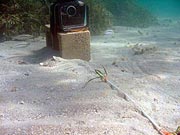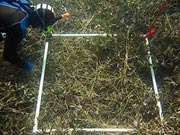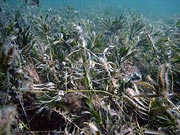
Research Projects – Seagrass

Posidonia australis is another common seagrass in Shark Bay. This temperate seagrass can form monospecific stands.
Turtles and dugongs aren't the only grazers in the bay - striped trumpters love Halophila spinulosa

An underwater videocamera records any grazes that feed on seagrass in an herbivory trial

Seagrass community survey - this one is easy!
Seagrass

relatively common along the edges of
banks where dugongs most commonly
graze

abundant seagrass in the bay and
forms dense monospecific stands.

servings of each species present in
the bay are woven into a rope.
Seagrass forms the foundation of the Shark Bay ecosystem. Covering more than 4000 square kilometers and comprised of between nine and twelve species, Shark Bay contains some of the world's largest continuous seagrass beds. One of the major questions of the Shark Bay Ecosystem Research Project is how the dynamics of these seagrass communities are influenced by the presence of large grazers (turtles and sea cows) and intact populations of their predators (in this case, tiger sharks) that have virtually disappeared from many areas of the world. To learn more about this the impacts of grazers on seagrass communities and how these effects might be influenced by tiger sharks, visit the Indirect Effects page. We are, however, conducting several other studies of seagrasses in the bay including documenting seasonal and spatial variation in community composition and nutient content of seagrasses across the entire bay and within the study area and investigations of grazing rates on various seagrass species. For example, we are deploying lines that are fitted with small surveys of each species of seagrass in the study area and recording the amount of each species that is eaten by grazers. Video cameras record the "herbivory trials" to help us figure out what grazers were feeding on particular seagrass species.
Grazing patterns of seagrasses vary with their nutrient content. Slow-growing species like Amphibolis and Posidonia are rarely grazed, while faster-growing species with higher nutrient content are heavily grazed. Some species are quickly removed from trials - mostly by Western striped trumpters.
Community and Nutrient Surveys
Since 2006 we have been measuring seagrass community composition at 70 randomly selected reference sites in our study area every four months. These sites represent deep, shallow bank edge habitats, and the middle of banks. At each site, we sample seagrass community composition and canopy height inside a 1m x 1m quadrat.During these surveys we also are collecting small samples of each seagrass species to determine the carbon, nitrogen, phosphorus, and fiber content. In addition, we have initiated a bay-wide study to look at patterns of nutrient content in seagrasses across the Shark Bay Region. We analyzing our results so check back soon to see what we have discovered and read about our exclosure studies here.
We have found that there is considerable spatial variation in patterns of nutrient limitation. The inner bay, where water flow is limited is Phosporus-limited while waters close to the open waters of the Indian Ocean are Nitrogen-limited. Areas in between are not nutrient-limited.
Investigating the Causes and Consequences of a Seagrass Dieoff
Starting in 2012, we began observing a widespread and large-scale dieoff of Amphibolis antarctica. We are not conducting surveys and collections of seagrasses to document the scale of the decline and determine if it is a response to a marine "heatwave." We also are begining studies to determine the impacts of this dieoff on the behavior and trophic interactions of other species.
Seagrass Publications
- Burkholder, D. A., M. R. Heithaus, and J. A. Fourqurean. 2013. Spatial pattern in seagrass stoichiometry indicates both N-limited and P-limited regions of an iconic P-limited subtropical bay. Marine Ecology Progress Series.
- Frankovich, T.A., J. Barr, D. Morrison and J.W. Fourqurean. 2012. Differential importance of water quality parameters and temporal patterns of submerged aquatic vegetation (SAV) cover in adjacent sub-estuaries distinguished by alternate regimes of phytoplankton and SAV dominance. Marine and Freshwater Research 63: 1105-1114.
- Fourqurean, J.W., G.A. Kendrick, L.S. Collins, R.M. Chambers and M.A. Vanderklift. 2012. Carbon and nutrient storage in subtropical seagrass meadows: examples from Florida Bay and Shark Bay. Marine and Freshwater Research 63: 967-983.
- Cawley, K. M., Y. Ding, J. Fourqurean, and R. Jaffé. 2012. Characterizing the sources and fate of dissolved organic matter in Shark Bay, Australia: A preliminary study using optical properties and stable carbon isotopes. Marine and Freshwater Research 63: 1098-1107.
- Burkholder, D. A., M. R. Heithaus, and J. A. Fourqurean. 2012. Feeding preferences of herbivores in a relatively pristine subtropical seagrass ecosystem. Marine and Freshwater Research 63: 1051-1058.
- Belicka, L. L., D. Burkholder, J. W. Fourqurean, M.R. Heithaus, S. A. Macko and R. Jaffé. 2012. Stable isotope and fatty acid biomarkers of seagrass, epiphytic, and algal organic matter to consumers in a nearly pristine seagrass ecosystem. Marine and Freshwater Research 63: 1085-1097.
- Kendrick, G. A., J. W. Fourqurean, M. Fraser, M. R. Heithaus, G. Jackson, K. Friedman, and D. Hallac. 2012. Science behind management of Shark Bay and Florida Bay, two P-limited subtropical systems with different climatology and human pressures. Marine and Freshwater Research 63: 941-951.
- Heithaus, M. R., A. Fird, A. J. Wirsing, L. M. Dill, J. Fourqurean, D. Burkholder, J. Thomson, and L. Bejder. 2007. State-dependent risk-taking by green sea turtles mediates top-down effects of tiger shark intimidation in a marine ecosystem. Journal of Animal Ecology 76: 837-844.
All photographs copyrighted; Images may be used for educational purposes. For use in other forms contact Mike Heithaus



